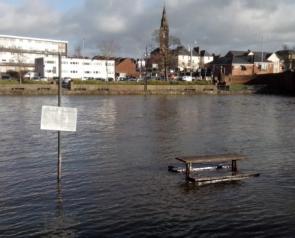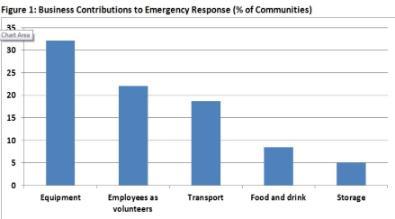The Role of Local Business in Community Resilience to Natural Hazards
Published: 1 April 2019
This research project, carried out by researchers at the University of Glasgow’s Dumfries Campus, sought to explore the role that businesses play in community resilience planning and response, through a national survey of community groups across Scotland and interviews with community representatives, businesses and local authority resilience officers.
Case Study
The Role of Local Business in Community Resilience to Natural Hazards
David Clelland, University of Glasgow
As part of a broader public policy focus on building resilience, ‘communities’ are being pushed to take on more responsibility for their ability to respond to emergencies, including natural hazards. The idea of local businesses as part of these communities, and as a potential source of support or resources to be mobilised in response to emergencies, is however somewhat under-developed.
This research project, carried out by researchers at the University of Glasgow’s Dumfries Campus and funded by the National Centre for Resilience, sought to explore the role that businesses play in community resilience planning and response, through a national survey of community groups across Scotland and interviews with community representatives, businesses and local authority resilience officers.
|
Background |
|
Official guidance from the Scottish Government, and support from Local Authorities, encourages community groups to develop resilience plans and registers of local volunteers and assets to be deployed in the event of an emergency situation. |
|
While responders are encouraged to consider businesses as one element of resilient communities, there is little guidance on the role that they can play in emergencies or on how communities can engage with them. |
The practice of formal community resilience planning is still developing in Scotland. Around a quarter (24%) of the 189 community groups responding to the survey had a community resilience or emergency response plan in place, and a further 14% were in the process of developing one. The majority of these groups had some sort of support from their local authority to help with this process, while some had also made use of the Scottish Government’s guidance material or been supported by the Scottish Flood Forum. Where groups did not have any formal plan, this was usually because they had not considered it or did not have adequate time or resources to develop one.

Local businesses help their communities to respond in a variety of ways. Of those communities that had responded to some sort of emergency – either planned or unplanned – in the last two years, businesses had made some sort of contribution in 58% of places. The most common type of resource that they were able to provid was machinery or equipment, including, for example, the use of heavy machinery to clear roads of fallen trees or snow, or generators where there was an interruption to power supplies. However, businesses also made a more varied range of contributions, including the time of their employees, helping volunteers to reach remote or vulnerable residents, and supplying hot food for volunteers or other affected members of the community. Businesses also help to raise the capacity of communities through, for example, providing storage for equipment or contributing financially to local fundraising initiatives.
Despite these positive experiences, only a minority of community groups had considered or engaged with local businesses in developing their resilience plans, and the potential contribution of businesses is not seen as very important to the development of community resilience relative to other elements.
A number of factors can be identified as inhibiting the role of businesses to community-level resilience activity:
- Many community councils and groups appear unlikely to consider the potential role that local businesses can play in planning and responding to emergencies or natural hazards. In addition, there is a perception amongst some community groups in very rural areas that there are no or very few businesses in their areas.
- The ‘asset register’ system used by community resilience groups was primarily designed as a register of individual local volunteers, rather than for identifying the distinctive contribution that could be made by local businesses and their assets.
- Engagement of businesses in community-level resilience planning appears to be almost exclusively the domain of very small and locally-owned firms. Although there is some anecdotal evidence of larger firms – such as supermarket or pub chains – providing ad hoc responses, where there is not at least some degree of local autonomy these appear unlikely to be approached by or engage with groups like community councils.
- There is resistance on the part of some businesses to the idea that such activities should be the responsibility of local authorities or other responders. Questions around insurance, liability and risk are also of concern to some businesses and are a disincentive to engagement.

Encouraging local planning by voluntary groups is well established as the preferred approach to developing community resilience. These findings highlight the potential contribution that local businesses can make to emergency response, and the scope to facilitate the more widespread engagement of business in community resilience activity.
|
Developing the Contribution of Businesses to Community Resilience |
|
The resources produced by the Scottish Government and local authorities – such as guidance and templates for compiling community resilience plans and asset registers – could do more to prompt community groups to consider what assets and resources businesses in their community might be able to contribute. This might include, for example, a dedicated section in communities’ asset registers identifying businesses in their area. |
|
If voluntary groups — and predominantly community councils – are to be the main mechanism for developing local community resilience, they are likely to require additional support if they are to effectively include local businesses in this process. In particular they would need help in reaching larger businesses, local branches owned elsewhere and others that are outside their existing informal networks. There may be scope here to build more local connections with other local authority departments, chambers of commerce, or enterprise agencies with a view to drawing more firms into community resilience planning. |
|
In practical terms, there is demand for further clear advice for community groups, potential volunteers and businesses engaging in community resilience activity about what would and would not be covered by existing insurance policies. |
First published: 1 April 2019

